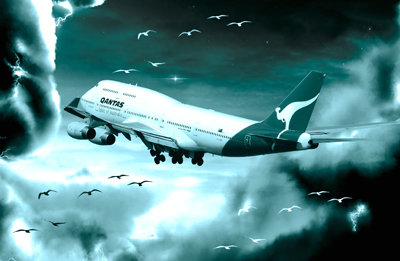Safety : Danger In The Skies

A study carried out during the period 1950 to 2006 on accidents involving commercial aircraft indicates that 60 per cent of these were attributable to human error, 21 per cent to mechanical failure, 11 per cent to weather or to causes beyond human control, such as bird strike, and 8 per cent to miscellaneous factors
On july 25, a qantas Boeing 747-400 ferrying 346 passengers and 19 crew from Hong Kong to Melbourne was convulsed by a loud bang followed by sudden loss of cabin air pressure. The plane diverted safely to Manila with no fatalities. The preliminary report submitted by the Australian Transport Safety Bureau stated that an oxygen cylinder in the cargo compartment had exploded and was propelled upward by the force of the explosion, tearing a 2 mlong aperture in the fuselage. The cylinder penetrated the floor of the passenger cabin directly above, fell back and created a gaping hole as it exited the plane. The explosion also damaged the electrical cables attached to the co-pilot’s controls leading to the malfunction of the right ailerons.
Defining Aviation Accident
The first ever air accident which resulted in a fatality took place a century ago in September 1908. The pilot was none other than the pioneer of powered flight, Orville Wright. The unfortunate individual who lost his life was Lieutenant Thomas Selfridge, a heavily built passenger who tipped the scales at 220 lbs. The aircraft took off and attained about 150 ft, descended to 75 ft, then suddenly side-slipped and hit the ground. The propeller blade The first ever air accident which resulted in a fatality took place a century ago in September 1908. The pilot was none other than the pioneer of powered flight, Orville Wright. The unfortunate individual who lost his life was Lieutenant Thomas Selfridge, a heavily built passenger who tipped the scales at 220 lbs. The aircraft took off and attained about 150 ft, descended to 75 ft, then suddenly side-slipped and hit the ground. The propeller blade splintered, severing the cables meant for controlling the rudder. hile Orville suffered a fractured leg, the passenger was hit by the engine and killed instantly.
Investigation into this accident was completed even before the crash. The pilot knew the actual reason for the crash even before the aircraft hit the ground. In those days, the aeroplane was a simple craft with wooden structure and wires running externally to operate the aerodynamic control surfaces. Today, an aeroplane is an infinitely complex machine and as aeronautical engineers describe it, an aeroplane has a million parts and devices and they perform in close formation to ensure a successful flight.
An aviation accident is defined in the ICAO, Annex 13 as an occurrence associated with the operation of an aircraft which takes place between the time a person boards the aircraft with the intention of flight and the time all such persons have disembarked, in which a person is fatally or seriously injured, the aircraft sustains damage or structural failure and/or the aircraft is missing or is completely inaccessible. An accident in which the damage to the plane is such that it must be written off or in which the plane is totally destroyed is often referred to as a hull loss.
Causes for Aircraft Accidents
Over the years, advanced science and engineering have developed innovative state-of-the-art systems that are far safer and reduced workload for the cockpit crew. Yet accidents occur, whether on the ground or in the air. These could be due to fire, tyre failure, systems malfunction or quite simply human error. Sometimes, accidents occur for no apparent reason at all.
A study carried out during the period 1950 to 2006 on accidents involving commercial aircraft indicates that 60 per cent of these were attributable to human error, 21 per cent to mechanical failure, 11 per cent to weather or to reasons beyond human control such as bird strike and eight per cent to miscellaneous reasons that included inadequacy of ground support systems, sabotage, hijack, destruction by ground fire or aerial action and explosion onboard. If the problem is not diagnosed correctly, the solution cannot be found quickly. In such a situation, corrective measures can not be implemented, hence accidents may reoccur.
Therefore, it is of utmost importance that investigations into aircraft accidents be conducted in a highly professional manner and follow-up action pursued diligently to its final conclusion to ensure that an accident does not recur for the same reason. Much has been discussed and written about human error, lack of support systems and adverse weather conditions. Here the focus is on Material Failure and Other Causes (see chart Triggers for Air Accidents).





